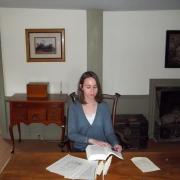History
Sinkable : obsession, the deep sea, and the shipwreck of the Titanic
Daniel (Daniel Evan) Stone
910.452 /Stone
History
April, 1912. The Titanic has scarcely disappeared before plans to find and raise her began. Yet seven decades passed before it was found. Why? And of some three million shipwrecks that litter the ocean floor, why is the world still so fascinated with this one? Stone spins a fascinating tale of history, science, and obsession, uncovering the untold story of the Titanic not as a ship but as a shipwreck. He takes readers through the two miles of ocean water in which the Titanic sank, showing how the ship broke apart and why, and delves into the odd history of our understanding of such depths. He interviews scientists to understand the decades of rust and decomposition that are slowly but surely consuming the ship. And Stone turns inward, looking at his own dark obsession with both the Titanic and shipwrecks in general. - adapted from publisher info
An assassin in utopia : the true story of a nineteenth-century sex cult and a president's murder
Susan Wels
364.1523/Wels
Nonfiction, History
From 1848 to 1881, a small utopian colony in upstate New York, the Oneida Community, was known for its shocking sexual practices, from open marriage and free love to the sexual training of young boys by older women. And in 1881, a one-time member of the Oneida Community, Charles Julius Guiteau, assassinated President James Garfield in a brutal crime that shook America to its core. This is the first book to weave together these explosive stories in a tale of utopian experiments, political machinations, and murder.
I was excited enough about this book that I went and bought a copy before the library got it...I'm hopeful it won't disappoint! For those of you who read Candice Millard's fantastic book about the assassination of President Garfied--"Destiny of the Republic"--and wondered what the heck his assassin had been getting up to before the event, this book might fill in some of those details for you. Turns out he spent a bit of time in the Oneida community in upstate New York, and if you think that it was all about making silverware, think again! There were a lot of interesting communities around this time, working to turn their ideal ways of life into a reality, and Oneida was one of the most successful. If you're a history buff with a penchant for a little of the weird, this book might be worthwhile. -Candice
American midnight : the Great War, a violent peace, and democracy's forgotten crisis
Adam Hochschild
973.91 /Hochschild
History
"A character-driven look at a pivotal period in American history, 1917-1920: the tumultuous home front during WWI and its aftermath, when violence broke out across the country thanks to the first Red Scare, labor strife, and immigration battles"--
President Woodrow Wilson, in his speech asking Congress to enter World War I, stated that we would make the world "safe for democracy." In "American Midnight," Adam Hochschild compellingly argues that at this time, democracy was in peril on the home front. From tramping down labor unions to jailing political opponents to silencing dissenting arguments (including removing public library books) to inflicting catastrophic violence against immigrants and Black Americans, America in the years of 1917-1920 was in a crisis. Hochschild explores the issues and themes that led America to the brink. He also dives in to the people who engaged and argued in the public sphere about their vision for America as well as those that were greatly impacted by this societal shift. It is a great read! -Anne M
The untold story of Larry Itliong : labor rights hero
Cristina Oxtra
j331.88 Itliong
Biographies, History
"You may have read about Cesar Chavez's leadership in organizing the well-known Delano Grape Strike and Boycott of the 1960s. But did you know it began as a strike led by Larry Itliong? He was a Filipino labor organizer who had also been working with grape pickers in California at the time. With key biographical information and related historical events, this Capstone Captivate book will uncover Itliong's story and show how it connects to Chavez's story"--
Take this opportunity to learn about an unsung hero of history and glean more information about where your food comes from! -Anne W
Sacred Britannia : the gods and rituals of Roman Britain
Miranda J. (Miranda Jane) Aldhouse-Green
200.9361 /Aldhouse-Green
Nonfiction, History, Religion, Political
Two thousand years ago, the Romans sought to absorb into their empire what they regarded as a remote, almost mythical island on the very edge of the known world - Britain. The expeditions of Julius Caesar and the invasion of AD 43 brought fundamental and lasting changes to the island. Not least among these was a pantheon of new Classical deities and religious systems, along with a clutch of exotic eastern cults including Christianity. But what of Britannia and her own home-grown deities? What cults and cosmologies did the Romans encounter and how did they in turn react to them? Under Roman rule, the old gods were challenged, adopted, adapted, absorbed and re-configured. In this fresh and innovative new account, Miranda Aldhouse-Green balances literary, archaeological and iconographic evidence (and scrutinizes their shortcomings and how we interpret them) to illuminate the complexity of religion and belief in Roman Britain, and the two-way traffic of cultural exchange and interplay between imported and indigenous cults. Despite the remoteness of this period, on the threshold between prehistory and history, many of the forces, tensions, ideologies and issues of identity at work are still relevant today.
This book is literally as the blurb says--it describes the religious atmosphere of Britain when the Romans blasted onto the scene, and uses various historical accounts and archaeological finds to give evidence. If that's your thing, then you'll love it! It can lean a little to the technical side, and assumes the reader might have a slight comfort level reading socio-archaeological articles, but the information is presented in nice, small bites so you don't get lost in the details. If deep British history is your cup of tea, and you don't need a lot of color photos to spice up the info, then you won't be disappointed. -Candice
The ruin of all witches : life and death in the New World
Malcolm Gaskill
974.402 /Gaskill
History
"A gripping story of a family tragedy brought about by witch-hunting in Puritan New England that combines history, anthropology, sociology, politics, theology and psychology. In Springfield, Massachusetts in 1651, peculiar things begin to happen. Precious food spoils, livestock ails, property vanishes, and people suffer convulsions as if possessed by demons. A woman is seen wading through the swamp like a lost soul. Disturbing dreams and visions proliferate. Children sicken and die. As tensions rise, rumours spread of witches and heretics and the community becomes tangled in a web of distrust, resentment and denunciation. The finger of suspicion soon falls on a young couple with two small children: the prickly brickmaker, Hugh Parsons, and his troubled wife, Mary. Drawing on rich, previously unexplored source material, Malcolm Gaskill vividly evokes a strange past, one where lives were steeped in the divine and the diabolic, in omens, curses and enchantments. The Ruin of All Witches captures an entire society caught in agonized transition between superstition and enlightenment, tradition and innovation"--
What makes a community turn on a neighbor, especially a tight-knit community? Hugh Parsons wasn't pleasant to be around. He was irascible, mean-spirited, and always seemed to show up when you didn't want him. Malcolm Gaskill takes us to Puritan Springfield, Massachusetts in 1651 where Hugh Parson's angry and bearish behavior leads to accusations of witchcraft. Unlike Salem with its long list of victims, Springfield, which happened 40 years before, ruined just one family. Was it just Hugh Parson's behavior? Did they just want to be rid of him? Or was the accusations about deeper fear? A brand new colonial settlement, Springfield was going through some drastic socio-economic-political-cultural changes. Gaskill paints an interesting portrait of a town on the brink. -Anne M
The revolutionary : Samuel Adams
Stacy Schiff
BIOGRAPHY Adams, Samuel
History, Biographies
"Thomas Jefferson asserted that if there was any leader of the Revolution, "Samuel Adams was the man." With high-minded ideals and bare-knuckle tactics, Adams led what could be called the greatest campaign of civil resistance in American history. Stacy Schiff returns Adams to his seat of glory, introducing us to the shrewd and eloquent man who supplied the moral backbone of the American Revolution. He employed every tool available to rally a town, a colony, and eventually a band of colonies behind him, creating the cause that created a country. For his efforts he became the most wanted man in America: When Paul Revere rode to Lexington in 1775, it was to warn Samuel Adams that he was about to be arrested for treason. In The Revolutionary: Samuel Adams, Schiff brings her masterful skills to Adams's improbable life, illuminating his transformation from aimless son of a well-off family to tireless, beguiling radical who mobilized the colonies"--
I really enjoy Schiff’s biographies and histories. She wrote one on Cleopatra and another called "The Witches," which chronicles the New England witchcraft hysteria of the 17th century. Both I recommend highly. Schiff is a great storyteller. She knows how to set the scene, provides interesting context, and then introduces her subject. This time it is founding father and known trouble-maker Samuel Adams. Now sort of a footnote in Revolutionary history, Adams played a huge role in providing unrelenting criticism of the king and parliament, leading to our country’s independence from Britain. Why was his legacy buried? Schiff's take is pretty interesting, especially through our 21st century lens. -Anne M
Seen and unseen : what Toyo Miyatake, Dorothea Lange, and Ansel Adams' photographs reveal about the Japanese American incarceration
Elizabeth Partridge
j940.547273 Partridge
Nonfiction, Literary Nonfiction, Picture Books, History, Art / Art History
"Legendary photographers Dorothea Lange, Toyo Miyatake, and Ansel Adams all photographed the Japanese American incarceration, but with different approaches and different results. This nonfiction picture book for middle-grade readers examines the Japanese-American incarceration and the complexity of documenting it through the work of these three photographers"--
Seen and Unseen is a must-read. An incredible marriage of photography, literary nonfiction, scrapbooking, illustration, survivor stories, and US History, Partridge and Tamaki use various media to bring Japanese American incarceration to light. This is suggested reading for all families, middle-graders, young adults, and adults, especially those interested in or affected by WWII. Seen and Unseen would be a great gift as well! -Casey
Come to this court & cry : how the Holocaust ends
Linda Kinstler
940.5318 /Kinstler
History
Investigating the death of Herberts Cukurs, a fugitive Nazi from Latvia who had served in her grandfather's unit, and modern efforts to exonerate him for his past actions, the author explores both her family story and the legacy of the post-Holocaust era in Europe, and how that legacy extends into the present.
This is like reading a WWII spy thriller, but knowing that this really happened add to the feeling of being enveloped in the story. Recommended for readers of Deborah Lipstadt's Denial and Christopher Browning's Ordinary Men. -Amanda
The sewing girl's tale : a story of crime and consequences in Revolutionary America
John Wood Sweet
364.1532 /Sweet
History
Summer, 1793. A crime was committed in the back room of a New York brothel-- the kind of crime that even victims usually kept secret. Instead, seventeen-year-old seamstress Lanah Sawyer charged a gentleman with rape. Her accusation sparked a raw courtroom drama and a relentless struggle for vindication that threatened both Lanah's and her assailant's lives. The trial exposed a predatory sexual underworld, sparked riots in the streets, and ignited a vigorous debate about class privilege and sexual double standards. Sweet takes us from a chance encounter in the street, and shows that if our laws and our culture were changed by a persistent young woman and the power of words two hundred years ago, they can be changed again. - adapted from jacket
John Wood Sweet brings the story of Lanah Sawyer to light in this historical courtroom account. What I found surprising is even though these cases were tried very differently because of the political and economic status of women in the 18th Century, there is a lot that 21st Century readers would find familiar. -Anne M






This is an interesting book for any person who had an obsession with the Titanic in the 4th grade. This gives a broader range of the Titanic tragedy and the various efforts to find it in the decades since. You'll meet some new Titanic-adjacent characters! -Amanda